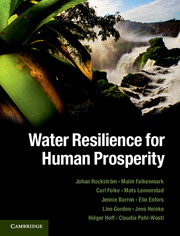Book contents
- Frontmatter
- Contents
- List of Contributors
- Preface
- Introduction to the book
- Acknowledgements
- Part I A new perspective
- 1 The role played by water in the biosphere
- Part II Living in a human-dominated world
- Part III Food production globally: in hotspot regions and in the landscape
- Part IV Governance and pathways
- Glossary
- Index
- References
1 - The role played by water in the biosphere
from Part I - A new perspective
Published online by Cambridge University Press: 05 August 2014
- Frontmatter
- Contents
- List of Contributors
- Preface
- Introduction to the book
- Acknowledgements
- Part I A new perspective
- 1 The role played by water in the biosphere
- Part II Living in a human-dominated world
- Part III Food production globally: in hotspot regions and in the landscape
- Part IV Governance and pathways
- Glossary
- Index
- References
Summary
The future of humanity will depend on our capacity to govern and manage water in ways that build resilience in an era of rapid global change and growing indications of large-scale, undesirable risks caused by the unsustainable exploitation of ecosystems. We define this strategic domain of global sustainability as ‘water resilience’, i.e. the role of water in achieving social–ecological resilience in support of sustainable development in the world. The chapter presents the new conceptual framework for reconnecting our societies to the biosphere and introduces the focus of the book: freshwater and the living systems of the biosphere.
The fundamental role of water in sustaining life on Earth
Water is understood, and has been for centuries, as a fundamental component of human well-being and socio-economic development. This insight dates back to the ancient water civilisations in human history, ranging from the Mesopotamian irrigation societies of the early years of the Holocene geological era, some 8000 years ago, to the great water-engineering feats of the Egyptian, Maya, Chinese and Roman empires, all the way through to sophisticated local contemporary water societies such as the Bali water temples and the intricate Dutch water-control boards. Nonetheless, there is ample evidence to suggest that we have reached a new situation in which our current way of governing and managing freshwater is becoming obsolete in relation to the social and environmental challenges facing humanity in the coming 50 years.
- Type
- Chapter
- Information
- Water Resilience for Human Prosperity , pp. 2 - 44Publisher: Cambridge University PressPrint publication year: 2014



